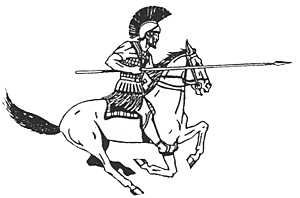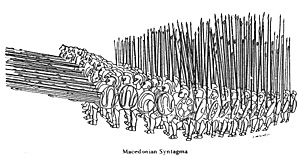 I game with 1/72 figures. Theyíre known by other names: 22mm, sometimes 20 mm. What they have in common is compatibility with the old Airfix figures that I first started seriously gaming with more than 30 years ago. Before that, Iíd tried a few rudimentary games with the old Britains 54s that Iíd received as childhood gifts, a small collection that I expanded with purchases from the old downtown Hallís store in Kansas City.
I game with 1/72 figures. Theyíre known by other names: 22mm, sometimes 20 mm. What they have in common is compatibility with the old Airfix figures that I first started seriously gaming with more than 30 years ago. Before that, Iíd tried a few rudimentary games with the old Britains 54s that Iíd received as childhood gifts, a small collection that I expanded with purchases from the old downtown Hallís store in Kansas City.
But that was a mismatched collection, odds and ends from a variety of periods and armies, though mostly British troops -- Guards and Highlanders and such. They didnít offer much scope for tabletop battles -- and they were prohibitively expensive for a kid with limited funds. When I discovered proper wargaming through Joe Morschauserís book ďHow to Play War Games in Miniature,Ē I knew I needed a different approach.
The book had a few photographs of the authorís games. The pictures were a revelation. One photo in particular caught my attention. It showed a World War II North African battle in progress, with a couple of HO scale tanks and a bunch of 8th Army and Afrika Korps soldiers. Morschauser identified the figures as Airfix and mentioned the inexpensiveness of the plastic figures. It wasnít long before I discovered a hobby shop that carried the Airfix line, all in that 1/72 scale. I found that the line wasnít limited to WWII North Africa. Airfix also offered Romans and ancient Britons, American Civil War, and medievals, two sets with lots of cavalry and infantry, marketed as the Robin Hood and Sheriff of Nottingham sets.
I bought many boxes in several periods. Soon enough, I had armies in ancient, medieval, ACW. (WWII never caught on with me.) Hardly any of those plastics got painted then but, hey, the Airfix figures in Morschauserís book werenít painted either. I also found the Wargames Research Groupís ancient-medieval rules (2nd edition, I still have my copy) and began my lifelong search for a set of rules that I could commit myself to. (Still looking.)
Those were the earlier days of gaming, when tables were meant to be covered with figures. Any self-respecting army had to total several hundred figures, even if the scale meant that you still were only representing a small battle or a small part of a bigger battle. I liked my Airfix plastics because they gave me big armies fast. But Iíd also caught the metal bug. I dreamed of those masses of nicely painted metal figures that would make my table groan under their weight. But how to get there?
Early on, I found an obscure company that made a range of Greeks and Republican Romans in exactly the same scale as all those cheap plastics. The company only lasted long enough to furnish one order to me, then promptly went out of business. But those old Bresicas gave me the idea that I could gradually convert my ďcollectionĒ from plastics to fully painted metals. It might take a while. In the meantime, Iíd still be able to use the plastics to fill out my orders of battle for those big armies that I wanted.
But thatís where things began to go wrong. In my search for metals, I found others that, from reading the catalogues, looked like they might be what I needed. I didnít have a good grasp of scale back then so I bought some figures I hoped would work with what I already had.
When those old Scruby and Minifig castings arrived, I eagerly opened the boxes. And I immedately noticed that the scales were slightly out of proportion to the 1/72 plastics and Bresicas. In fact, as I later discovered, they were true 25s. This wasnít really an encounter with scale creep. It was an encounter with scale incompatibility. The 1/72s and the true 25s just didnít look right when standing next to each other. But my options were limited in those days of gaming-yesteryear and I began gathering and painting those 25s, too.
Before long, I had lots of metal ancients and medievals, just like I wanted. But the collection was inherently unsatisfying because the different sizes of figures didnít match up. By then, Iíd also found the Musket Miniatures range of 1/72s (well, MM calls Ďem 22mm). They fit perfectly with my old plastics, lots of which were getting a coat of paint by now. I found myself doing most of my actual gaming with those ACW guys. They were a nice fit.
The day came when I confronted reality. (As usual, it took me a long time.) The ancients/medievals that Iíd been collecting for so long werenít one collection. They were two. There were 1/72s and there were the true 25s. They didnít go together, not to my eye anyway. So they didnít belong together. Luckily, Iíd found a solution by then. Newline miniatures was producing a perfectly compatible set of 1/72 metal ancients. Theyíd fill out my 1/72 ancients collection just fine.
 Thatís how I happened to have ancients in two different scales, not all that unusual perhaps, except that these two were so close in size, separated by a mere 3mm. As the 1/72s rounded themselves out, the 25s also grew, though at a smaller rate. With them, I decided to complete several ancient DBA armies, with the eventual aim of selling them off. Even after all these years, I still havenít completed that project.
Thatís how I happened to have ancients in two different scales, not all that unusual perhaps, except that these two were so close in size, separated by a mere 3mm. As the 1/72s rounded themselves out, the 25s also grew, though at a smaller rate. With them, I decided to complete several ancient DBA armies, with the eventual aim of selling them off. Even after all these years, I still havenít completed that project.
The 1/72s werenít going on the sales block though, even if the focus of rules has shifted to element-based armies, generally requiring fewer figures for a game. Iíve found even more metals in 1/72ómedievals from Kennington. And plastics have improved enormously since the Airfix days. The modeling on some of todayís Zvezdas is phenomenal. If you get a chance, take a look at the centurion in the Marian Roman set. Amazing detail. The word among plastics enthusiasts is that this is the golden age of plastics gaming. There are so many good sets constantly coming on the market, many of them in a harder plastic that holds paint better than the old rubbery Airfix types.
I agree this is a golden age of plastics, but Iíd go further. Itís really a golden age of 1/72s, whether itís plastics or the wide variety of metals thatís available in that scale nowadays. No, the variety canít match up with whatís out there in 15mmóa small, fiddly scale to my way of thinking. But thereís plenty to keep a 1/72 guy happy.
I suspect that most of us who collect and game in this scale donít mind mixing metal and plastics, something that would horrify the metal purists. But this 1/72 enthusiast got where he is the hard way. Now that Iíve arrived, Iím not about to give it up.
Back to Table of Contents -- Lone Warrior # 150
Back to Lone Warrior List of Issues
Back to MagWeb Magazine List
© Copyright 2005 by Solo Wargamers Association.
This article appears in MagWeb.com (Magazine Web) on the Internet World Wide Web.
Other articles from military history and related magazines are available at http://www.magweb.com
